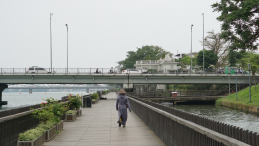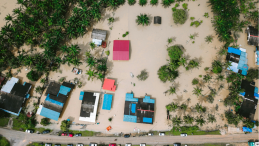The city of Hue in central Viet Nam is frequently affected by floods. In 2020 and 2023 floods caused severe damage and threatened people’s lives and well-being. With climate and socioeconomic change, flood impacts in Hue are expected to intensify without stronger disaster risk reduction measures.
To better understand and address these challenges, UNU-EHS researchers Dominic Sett and Andrea Ortiz Vargas have led two new reports on flood risks and adaptation as part of the FloodAdaptVN project. Together, the reports guide readers through questions of risk and resilience, from understanding how floods impact citizens and how people adapt to assessing nature’s role for better protection and building resilience. We sat down with Dominic and Andrea to learn about their findings and what they mean for the future of flood resilience in Hue:
What does your assessment reveal about the challenges people living with floods in Hue face?
Floods in Hue affect virtually everyone. In the past, they caused fatalities and destroyed homes, schools, hospitals, farmland and infrastructure. These damages worsened impacts on people’s everyday lives, limiting access to essential services, such as education and healthcare, and reducing income from farming and tourism. Furthermore, we found significant environmental impacts from flooding, such as water contamination, which caused health issues for people as well as for plants and animals. Floods also did damage to trees, including to mangroves planted in an effort to adapt to climate change.
What are the main reasons Hue is so prone to flooding and what role do urbanization and climate changes play?
It is really a combination and interaction of factors that put Hue at high risk. Urbanization plays a big role. As the city’s population is rapidly growing, more buildings and roads are constructed, which seal surfaces, preventing rainwater from infiltrating the ground. Climate change adds to this with heavier rainfalls projected for Hue, which intensifies floods. This intensification pushes government and community flood protection strategies to their limits, leaving the city highly vulnerable.
What kinds of choices do people in Hue have to protect their homes and livelihoods, and how are these decisions shaping the future of the city?
Flood protection is not only a matter of choice, but also of capability. When we talked to citizens, many said they wish to structurally adjust their housing, for example by raising their homes or installing flood-proof doors. However, these actions are expensive and often technically difficult to implement. Therefore, providing assistance through financial means or a training would enable more people to realize their own protection and hence contribute to the overall resilience of the city.
Since nature can also play a role in protecting people from floods, how do ecosystems in or around Hue help in protecting people and livelihoods?
Upstream of Hue, there are large forest areas that have a crucial role in reducing flood risk. Protected forests in particular help regulate water flow, which directly reduces impacts of floods on people and their livelihoods. However, their value goes beyond flood control. Forests also provide food, raw materials and income from tourism. Families can use this income to strengthen their homes or diversify their livelihoods. In this way, the forests support flood hazard reduction, as well as reduced exposure and vulnerability. In addition, they stabilize soils which helps to prevent landslides. In the future, they will become even more important as heat stress is another increasing impact of climate change in the area. Forests can help mitigate such climate-related risks. So, they really work on several levels to reduce risk for communities downstream.
With climate change bringing more extreme weather events, what does resilience look like for Hue in the coming decades and how can the city balance growth, safety and sustainability?
Building resilience in Hue requires a holistic approach that combines social, ecosystem-based and structural measures. Structural solutions, like dykes, provide immediate protection but may become insufficient over time, particularly in light of climate change extremes. Ecosystem-based adaptation, on the other hand, can grow and adapt. A good example is the conservation and expansion of mangrove forests along the coast, which help reduce risks from sea level rise and storm surges while creating opportunities for local communities, such as eco-tourism.
During our conversations with citizens and experts in Hue, we realized that people in Hue are aware of flood risks and adapt as best as they can. Yet ongoing and projected climate impacts show that more transformative investment is needed. Beyond building structures, resilience means strengthening social capacity, supporting communities and integrating nature-based solutions to create a safer, more sustainable future.





